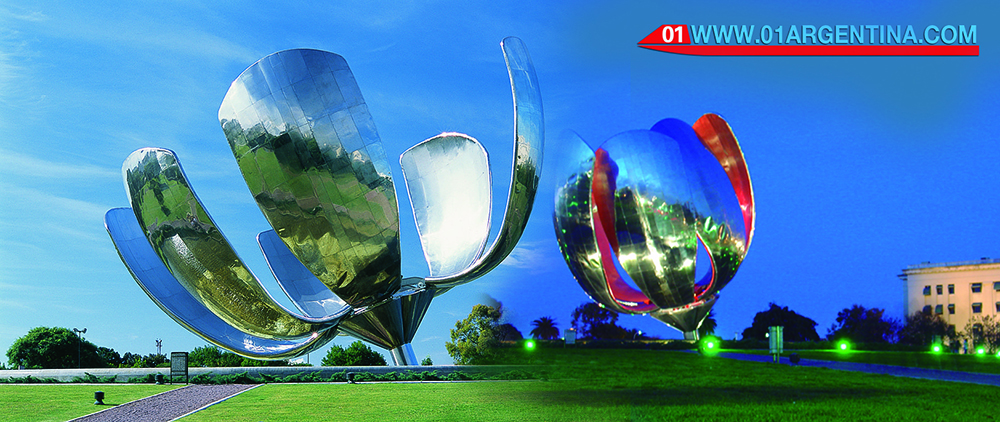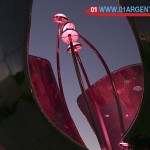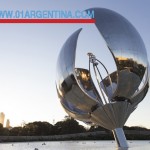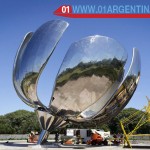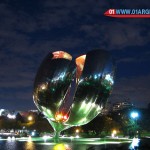The Floralis Generica opens and closes with sunlight
The Generic Floralis is one of the main tourist attractions in Buenos Aires and it is more than 20 meters, it weighs 24 tons and opens and closes with sunlight. A sudestada wind damaged shortly after its opening in 2002. Go back to work after a long and complex repair work.
Measured over 20 meters, it weighs 24 tons and was the first mobile sculpture mounted on the City hydraulics and photocells. He returned to work at its best, after a long and complex repair work took more than six months: the Floralis Generic, one of the monuments of Buenos Aires, and shines with all its splendor in the United Nations Plaza, on the Avenida Figueroa Alcorta
Repair work began in September last year, with input from private companies and the expertise of the National Technological University (UTN).
They included several tasks:
• underground piston arrangement, which allows the petals open and reach a diameter of 32 meters.
• preventive Shoring one of six petals. Each weighs 4,000 kilos and is 23 meters high.
• Fix the source engines around the sculpture.
• Control and adjustment of wind sensors (anemometers) that cause the petals to close when windy, because if they break remain open to the reluctance. And so does the rain, if the petals are not closed, the water weight is damaging.
• Reinforcing the structures that make up the petals with aluminum plates and welds, so that they can withstand heavy storms.
In addition to the sensors own sculpture, operation and engine room is connected Hydrometeorological Network Sensors and Early Warning System of the City of Buenos Aires, controlled by the Directorate General of Red Storm.
“We are proud to have been part of the team that restored, put in value and made work again Flower. Today this monument is an icon for which he is recognized to the City in the world, comparable to the Obelisk and so it is good to be in their best “said the Minister of Environment and Public Space Buenos Aires, Edgardo Cenzon.
“As we move into the arrangements are new problems. For example, we realized that two newly petals when we played the piston to 85% of its operation. Our goal is that the flower does not break again, “said Undersecretary of Public Space Maintenance of Buenos Aires, Rodrigo Silvosa.
History and characteristics
The Floralis Generica is a metal sculpture is 20 meters in the Plaza of the United Nations, Avenida Figueroa Alcorta, of the Autonomous City of Buenos Aires, that city flattered by Argentine architect Eduardo Catalano. The structure was inaugurated on April 13, 2002 with materials provided by the aircraft company Lockheed Martin Aircraft Argentina.
The sculpture is located in the middle of a park of four acres of tree lined, surrounded by paths that zoom in and providing different perspectives of the monument and placed above a reflecting pool, which apart from fulfilling its aesthetic function, protects . It represents a large flower made of stainless steel, aluminum skeleton and reinforced concrete, looking into the sky, reaching toward him six petals. Weighs eighteen tons and is 23 meters high.
At the time he was sued the sculptor Eduardo Omar Urich to take care of as a logo engraved on marble monument.
The original mechanism makes the flower opens and closes according to the solar radiation, a process that takes more than 20 minutes making the monument in a public daily spectacle of the city.
The monument weighs 24 tons and is taxed at all the flowers; why the author decided to name in Latin, because that is the language used for the botanical name of the species.
It was the first mobile sculpture mounted on a hydraulic system and photoelectric cells.
A strong sudestada
The Floralis Generic worked briefly after its opening in 2002 until the mechanism was broken because one of the petals was overcome by strong winds sudestada, causing the imbalance of the whole structure.
Since then, Repair attempts were unsuccessful because the company had built it left the country without leaving the flat. The designer and donor of monumental sculpture, the architect Eduardo Catalano, died, so it was not possible to access the information in it had in its possession.

